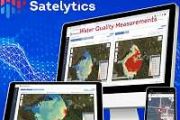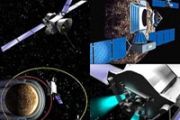
Copernical Team
Phantom Space acquires Micro Aerospace Solutions
 Phantom Space Corporation has reported the successful acquisition of Micro Aerospace Solutions, a leader in space communications systems, space propulsion systems, and electrical hardware design for spacecraft and rockets. The acquisition has further propelled Phantom towards its goal of democratizing space access by mass manufacturing launch vehicles, satellites, and space propulsion systems. T
Phantom Space Corporation has reported the successful acquisition of Micro Aerospace Solutions, a leader in space communications systems, space propulsion systems, and electrical hardware design for spacecraft and rockets. The acquisition has further propelled Phantom towards its goal of democratizing space access by mass manufacturing launch vehicles, satellites, and space propulsion systems. T Delivery partner sought to inspire the next generation of space enthusiasts
 As we work towards establishing commercial vertical and horizontal small satellite launches from UK spaceports from 2022, the UK Space Agency is undertaking a programme of educational activity to inspire young people, particularly those from under-represented groups, to engage with STEAM (Science, Technology, Engineering, Art and Maths) subjects. We hope to inspire the next generation of British
As we work towards establishing commercial vertical and horizontal small satellite launches from UK spaceports from 2022, the UK Space Agency is undertaking a programme of educational activity to inspire young people, particularly those from under-represented groups, to engage with STEAM (Science, Technology, Engineering, Art and Maths) subjects. We hope to inspire the next generation of British Most detailed-ever images of galaxies revealed using LOFAR
 The universe is awash with electromagnetic radiation, of which visible light comprises just the tiniest slice. From short-wavelength gamma rays and X-rays, to long-wavelength microwave and radio waves, each part of the light spectrum reveals something unique about the universe.
The LOFAR network captures images at FM radio frequencies that, unlike shorter wavelength sources like visible li
The universe is awash with electromagnetic radiation, of which visible light comprises just the tiniest slice. From short-wavelength gamma rays and X-rays, to long-wavelength microwave and radio waves, each part of the light spectrum reveals something unique about the universe.
The LOFAR network captures images at FM radio frequencies that, unlike shorter wavelength sources like visible li Astronomers find a 'break' in one of the Milky Way's spiral arms
 Scientists have spotted a previously unrecognized feature of our Milky Way galaxy: A contingent of young stars and star-forming gas clouds is sticking out of one of the Milky Way's spiral arms like a splinter poking out from a plank of wood. Stretching some 3,000 light-years, this is the first major structure identified with an orientation so dramatically different than the arm's.
Astronom
Scientists have spotted a previously unrecognized feature of our Milky Way galaxy: A contingent of young stars and star-forming gas clouds is sticking out of one of the Milky Way's spiral arms like a splinter poking out from a plank of wood. Stretching some 3,000 light-years, this is the first major structure identified with an orientation so dramatically different than the arm's.
Astronom Celestial Sleuth corrects historical record on Gegenschein discovery
 The discovery of the gegenschein-a faint nighttime glow that appears as a diffuse brightening at the anti-sun, the point in the sky exactly opposite the sun-has usually been attributed to French Jesuit astronomer Esprit Pezenas in 1730.
Now, Texas State University astronomer, physics professor emeritus and Texas State University System Regents' Professor Donald Olson has applied his distin
The discovery of the gegenschein-a faint nighttime glow that appears as a diffuse brightening at the anti-sun, the point in the sky exactly opposite the sun-has usually been attributed to French Jesuit astronomer Esprit Pezenas in 1730.
Now, Texas State University astronomer, physics professor emeritus and Texas State University System Regents' Professor Donald Olson has applied his distin Saturn makes waves in its own rings
 In the same way that earthquakes cause our planet to rumble, oscillations in the interior of Saturn make the gas giant jiggle around ever so slightly. Those motions, in turn, cause ripples in Saturn's rings.
In a new study accepted in the journal Nature Astronomy, two Caltech astronomers have analyzed those rippling rings to reveal new information about the core of Saturn. For their study,
In the same way that earthquakes cause our planet to rumble, oscillations in the interior of Saturn make the gas giant jiggle around ever so slightly. Those motions, in turn, cause ripples in Saturn's rings.
In a new study accepted in the journal Nature Astronomy, two Caltech astronomers have analyzed those rippling rings to reveal new information about the core of Saturn. For their study, NASA's Ingenuity helicopter completes 12th Mars flight
 NASA's Ingenuity helicopter completed its 12th flight on Mars, officials said early Tuesday, as it scouts out the Martian terrain for the Perseverance land rover.
The 4-pound autonomous aircraft flew over the South Seitah region of the Red Planet, traveling a total of 1,476 feet round trip at a height of nearly 33 feet for 169 seconds, NASA's Jet Propulsion Laboratory said via Twitter.
NASA's Ingenuity helicopter completed its 12th flight on Mars, officials said early Tuesday, as it scouts out the Martian terrain for the Perseverance land rover.
The 4-pound autonomous aircraft flew over the South Seitah region of the Red Planet, traveling a total of 1,476 feet round trip at a height of nearly 33 feet for 169 seconds, NASA's Jet Propulsion Laboratory said via Twitter. NASA benefits from Lunar surface simulant testing
 To safely reach the Moon, a lunar lander must fire its rocket engines to decelerate the spacecraft for a soft touchdown. During this process, the engine exhaust stirs up regolith - the dust and rocks on the lunar surface - creating a host of potential challenges, from destabilizing the lander to damaging instruments and reducing visibility.
To dig into this problem, a team from NASA's Kenn
To safely reach the Moon, a lunar lander must fire its rocket engines to decelerate the spacecraft for a soft touchdown. During this process, the engine exhaust stirs up regolith - the dust and rocks on the lunar surface - creating a host of potential challenges, from destabilizing the lander to damaging instruments and reducing visibility.
To dig into this problem, a team from NASA's Kenn Curiosity Mars Rover explores a changing landscape
 Images of knobbly rocks and rounded hills are delighting scientists as NASA's Curiosity rover climbs Mount Sharp, a 5-mile-tall (8-kilometer-tall) mountain within the 96-mile-wide (154-kilometer-wide) basin of Mars' Gale Crater. The rover's Mast Camera, or Mastcam, highlights those features in a panorama captured on July 3, 2021 (the 3,167th Martian day, or sol, of the mission).
This locat
Images of knobbly rocks and rounded hills are delighting scientists as NASA's Curiosity rover climbs Mount Sharp, a 5-mile-tall (8-kilometer-tall) mountain within the 96-mile-wide (154-kilometer-wide) basin of Mars' Gale Crater. The rover's Mast Camera, or Mastcam, highlights those features in a panorama captured on July 3, 2021 (the 3,167th Martian day, or sol, of the mission).
This locat Europe's Vega rocket blasts off with Airbus observation satellite

A European Vega rocket lifted off Monday night from French Guiana carrying an Earth observation satellite and four miniature "cubesats".
It was the second launch this year of the Vega, a crucial component of European ambitions to compete with rivals such as Elon Musk's SpaceX in the booming commercial aerospace market.
The rocket blasted off from the Guiana Space Centre in Kourou at 10:47 pm (0147 GMT), successfully delivering the satellites in just under two hours.
Its main cargo was a high-resolution satellite, the second of four for a new Earth observation constellation operated by Airbus. The first was put in orbit in April by a Vega rocket.
The Pleiades Neo constellation will offer high-resolution imaging of Earth for military or civilian uses such as disaster response, according to Airbus.
Vega's operator Arianespace is a subsidiary of the ArianeGroup, of which Airbus owns half.































